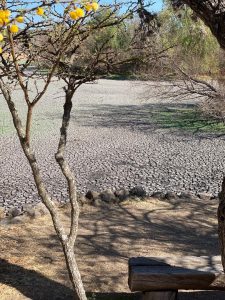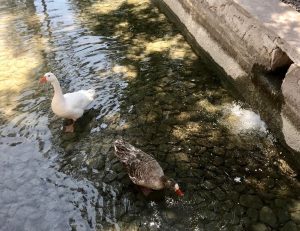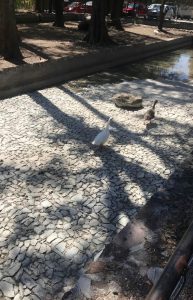Last Sunday when my friends Kharin and Ruth hiked El Charco del Ingenio (The Mill Pond), home of San Miguel de Allende’s exquisite botanical gardens and nature reserve, they discovered to their shock that most of the enormous reservoir there had gone dry. Its bed was cracked and veined, baked in the sun:

And last week, when I walked to one of my favorite spots, the duck pond near San Miguel’s art and design center, Fabrica la Aurora, I saw that the pond was mostly dry. Instead of gliding gracefully in the water, as I’ve always loved watching them do, the more than a dozen ducks and geese were waddling disconsolately along the length of the pond’s dry stone bottom:
What is going on? I had to wonder. Could this possibly be normal? Should I – and these ducks and all the living beings in the nature reserve as well as in this community — panic? Is this a life-threatening drought? Is climate change to blame?
Yes, we’re nearing the end of the dry season here in this region of Mexico, and the earth is naturally parched. There’s been no rain since about October, and it won’t rain again for a couple of months. To some extent this seems natural to me because I’ve lived for many years elsewhere in the tropics.
Growing up in the northeast United States, I experienced all sorts of precipitation all throughout the year every year. But I subsequently learned that regions in what is known as the tropical rain belt have just two seasons – wet and dry – which last for months on end. This includes Mexico.
According to Wikipedia, “The rain belt reaches roughly as far north as the Tropic of Cancer and as far south as the Tropic of Capricorn. Near these latitudes, there is one wet season and one dry season annually. At the equator there are two wet and two dry seasons, as the rain belt passes over twice a year, once moving north and once moving south. … During the dry season, humidity is very low, causing some watering holes and rivers to dry up.”
One example: Gabon, where I served for two years in the U.S. Peace Corps from 1996 to ’98, is a small African country, about the size of Colorado, that straddles the equator. It has year-round 100+-degree F. temperatures, close to 100 percent humidity, and an average annual rainfall of more than 120 inches. The driest months are June, July, August, and early September. The rest of the year is muggy and scorching, with heavy rains from evening until morning.
In Gabon I used to label the seasons by the consistency of the soil: It was either the thick-squishy-mud season or the red-swirling-dust season. There was no in-between.
But this current situation here and now in San Miguel de Allende, Mexico, seemed alarming to me. (Was it the wicked hand of climate change at work?) So I asked an expert, Rob Lerner, who is a board member and technical advisor to the local nonprofit Caminos de Agua, whose mission is to improve human health and community well-being through adequate and affordable access to clean water, to briefly enlighten me.
“The Charco going dry at the end of the dry season is nothing new,” Rob informed me. “Droughts happen. This season may have been the driest in decades, but no single year or weather event can be attributed to climate change – only that climate change makes such outcomes more likely.”
In other words, I surmised, we’ll live – at least for the near future.
But now when I look more closely at Kharin’s recent photo taken at El Charco, I see something else. I see it as a metaphor for the way I (and perhaps others?) feel at times, inside of ourselves: desiccated, dusty, cracked open. Lately, my heart, soul, and creative juices feel as if they’ve gone dry. I ask myself, Why? And I get no solid answers.
So I tell myself, It’s just the dry season. Don’t worry. You’ve lived through enough dry seasons to know this will pass. The rains will come. Hang on.
Everything, King David’s son wrote, has a season, and every season has a purpose (Ecclesiastes 3:1-11). God, says Solomon, “hath made every thing beautiful in his time” (verse 11).
I returned to the duck pond this week to see that water is now being pumped into it. I stood for a long time at the fence, watching the ducks happily wade, ankle-deep, in their pond, patiently waiting for it to fill up. This gave me hope.

~ ~ ~ ~ ~ ~ ~
For more about Caminos de Agua, go to: https://caminosdeagua.org/.
For more about the botanical gardens at El Charco, go to: www.blog.bonnieleeblack.com/starship/
For more about the duck pond near Fabrica la Aurora, go to: www.blog.bonnieleeblack.com/something-about-ducks/



Bonnie, I was at the Fabrica duck pond the week before last, and observed municipal workers draining and cleaning the pond of accumulated algae and muck. Normal maintenance!
Yes, thanks, Ron. When I returned this week and asked, I was also told the same. Nice to know!
Thank you Bonnie. An interesting read. As a former registered dietitian, issues of access to water, drinking water, and the work of Caminos de Agua, are passion issues to me.
Thank YOU, Lyn. I know how passionate you are about Caminos de Agua. I hope all of my WOW readers go to their website (given at the end of my post) to learn more about their great work and the fuller story about water issues in this area.
Weather is something over which we have the least control and yet the most resistance. I liked your reminder that “It’s just the dry season. … You’ve lived through enough dry seasons to know this will pass. The rains will come.” Whenever I go through a low period, I remind myself that all gardens need fallow periods, so the soil can rest and gain nutrients. We all have our ways of acclimating to the weather, don’t we?
Yes, absolutely, BeDear! You’re so right.
Your observation makes sense yo me. We have been on “pause” for so long and creativity suffers the most. Let’s all hope the water flows again and soon, so we can feel afloat and buoyant once again.
You’ve been bearing up so bravely this past year, Michael dear. Those of you in the performing arts in NYC have been especially hard hit by this pandemic. I applaud your strength and resilience. Yes, this dry season will end. Hang on!
Your writing got me this week at a moment of feeling dried up. Thanks – waiting for the rain!
Kate
So happy to hear this, Kate. Thank you.
Having lived for eighteen years overlooking the reservoir Obraje at the bottom of the Charco, I can attest to the fact that it does dry out some years. When I first moved to SMA and looked out at the reservoir, there were trees in the middle but then a few years later when it was dry enough to walk across I saw many people come and cut down the trunks and trees for firewood for cooking. A few weeks after the rains come in June,
it will be full again and then if they open the gates up in the Charco at some point, there will be a waterfall coming down the
side of the cliff that will flow into the reservoir! It is a magical and beautiful sight and sound. I miss that experience as I moved from that house three years ago.
Thank you so much for sharing your memories, dear Babs! And thanks too for the comforting reassurance that the reservoir will indeed fill up again.
Dear Bon,
I hope the reservoir fills up too. I feel like I live in a country where there are enough deniers to ensure nothing will ever be done about climate change. Not as long as there is money to be made destroying the earth and money to be spent bribing the powerful. In a world where corporations don’t care if people live or die, I don’t see much hope for ducks.
Love,
Paul
It does get disheartening, doesn’t it, dear Paul. My little sliver of good news, though, is that I walked by the duck pond earlier today to see that the pond has been refilled with fresh water and the ducks are delighted, paddling around like mini river boats. Made my day. Love to you, BB xx